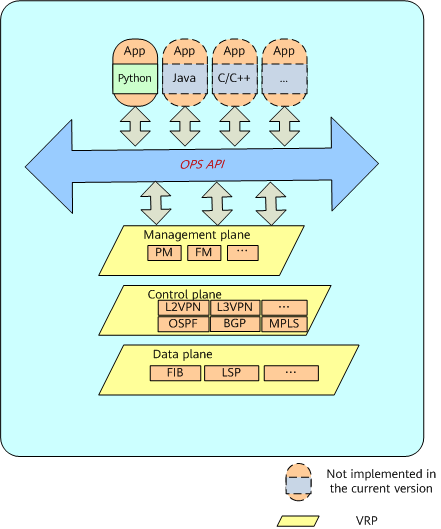OPS Architecture
Leveraging Huawei-developed Versatile Routing Platform (VRP), the OPS enables customized applications to interwork with management-, control-, and data-plane modules on the VRP through open APIs, expanding the overall device functionality. Figure 1 shows the OPS architecture.

- OPS APIs described in this document are RESTful APIs.
- In the current version, OPS APIs can be invoked only in the Embedded Running Environment (ERE).
Module Name |
Description |
|---|---|
OPS |
Open programmability system. |
Python |
Type of application script supported by the OPS. The system integrates a running environment for Python scripts. |
OPS API |
OPS application programming interface through which the applications in the OPS can interwork with the modules on the VRP. |
VRP |
Operating system used by Huawei data communication devices. It provides a unified user interface and management interface that utilize a unified real-time operating system kernel, software-based IP forwarding engine, and route processing and configuration management plane. The VRP supports control plane functions and defines the interface standards in the forwarding plane for interconnection. |
Management plane |
Plane that provides management functions for the entire system, such as performance management (PM) and fault management (FM). It also manages all planes. |
Control plane |
Plane that controls calls and connections. It sets up and releases connections through signaling, and can restore a connection if a failure occurs. The control plane also performs other functions, including delivery of routing information, in support of call and connection control. The control plane supports protocols such as L2VPN, L3VPN, OSPF, BGP, and MPLS. |
Data plane |
Plane that provides virtual network paths through functions, such as forwarding information base (FIB) and label switched path (LSP), to transmit data between nodes. |
OPS APIs are designed based on REST architectural principles. These principles enable web services to be designed with a focus on system resources. The OPS opens managed objects (MOs), each of which is uniquely identified by a Uniform Resource Identifier (URI), to achieve device openness. You can perform operations on these objects using standard HTTP methods, such as GET (query), PUT (modify), POST (create), and DELETE (delete).
Currently, the system integrates the Python running environment, enabling it to run Python scripts. Such scripts need to define the method of sending HTTP requests to the system based on OPS APIs. By sending HTTP requests to the system, Python scripts can be used to manage the system.
For details about OPS APIs supported by the device, see OPS API Reference.
